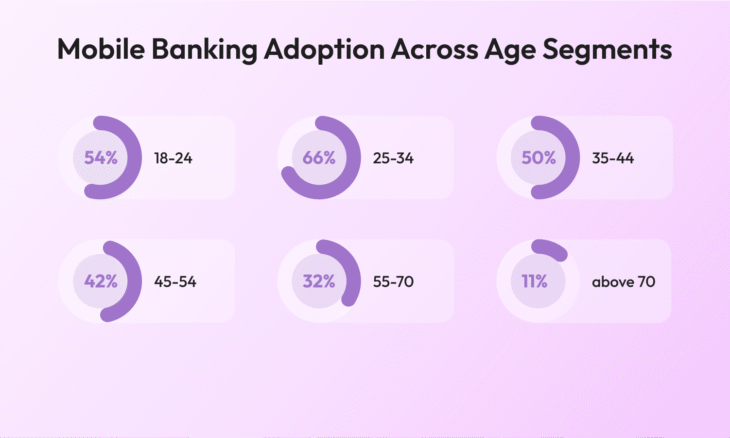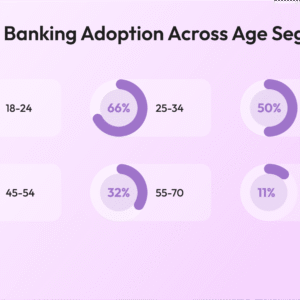
The use of Generative AI in the banking industry is becoming a regular practice, rather than a mere sci-fi concept. Banks stepped up their activities in the previous year to incorporate AI technologies that are not just content analyzing machines, but also offer meaningful content, simulate human interaction, and enhance departmental services.
Here, the most exciting advances in generative AI in the banking sector are discussed as well as what they will mean to clients, employees, and the financial sector in the future.
AI-Based Chatbots as Financial Advisors
Traditional chatbots were only able to provide pre-written responses. Due to the integration of massive language models such as GPT-4 and Claude into banking app development, customers have been offered personalized solutions to complex financial questions in real-time.

Banks such as JPMorgan Chase and Bank of America have adapted their virtual assistants to handle more complex conversations, including describing lending possibilities, summarizing spending patterns, and recommending investment products. On these days, these assistants speak naturally, detect interactions with consumers, and even adjust their tone based on the client’s emotional status.
Following the deployment of a generative A.I. assistant, which might suggest preventive budgeting tips and summarize account transactions, a large European bank claimed that the frequency of customer care calls had reduced dramatically by 45%.
Customized Financial Products On a Large Scale
Banks are applying generative AI to help them stop offering products that fit everyone, but instead provide highly customized products. Now, AI can develop dynamic financial solutions by analyzing consumer data, including transaction history, spending habits, sources of income, and even life goals.
An individualized proposal, with variable limits, interest rates, and reward categories based on real-time risk evaluation and preferences, can be presented to a consumer on application to take on a credit card.
Mortgage lending artificial intelligence (AI) systems generate loan recommendations based on the borrower’s job condition, previous credit history, and local real estate trends. These are recommendations that are made immediately, often within seconds, and not pre-designed templates.
Compliance Automated Report Generation
Compliance report compilation is one of the most boring tasks in the banking field. Through heavy regulation, financial institutions waste thousands of hours developing summaries for use in internal audits and regulatory filings.
Microsoft Copilot and Gemini (the AI) by Google have been trained to produce these reports based on structured data. They extract data from various sources, process it, and produce documentation that meets the standards with its context, commentary, and risk summaries.
The banks in Singapore and the UAE are among the first to rely on AI-generated regulatory reports, enabling them to accelerate submission timelines by minimizing human error.
Synthetic Data for Safer AI Training
Banking is very concerned about customer privacy. However, by training AI models on sensitive customer information, a risk is generated. Here lies the solution of synthetic data presented by generative AI.
Synthetic data sets replicate real banking information, but are not used to reveal any personal information. They are capable of replicating the patterns and behaviors of real transactions, making them ideal for testing fraud detection algorithms, training chatbots, or simulating a new product launch.
Large banks, such as HSBC and Goldman Sachs, are also investing in synthetic data generation to train machine learning models safely. This is both effective in safeguarding the data of customers, as well as speeding up innovation without the need to jump through legal hurdles.
Fraud Detection and Risk Assessment
AI is already used by banks to detect fraud. However, generative AI takes it a step further by creating possible fraud cases that banks are not yet aware of.
AI systems have already learned to simulate emerging types of fraud, including synthetic identity fraud and AI-generated phishing attacks. Defense systems are trained to identify anomalies in a better way by using these simulated threats.
Recently Credit Suisse ran a test system that created hundreds of hypothetical cases of fraud based on customer behaviour patterns. What it achieved was a 30 percent early fraud detection rate relative to a traditional rule-based system.
Smarter Underwriting and Processing of Loans
Generative AI is enhancing the underwriting processes through the development of automatic coverage of applicant profile summaries. Rather than sifting through bank statements, tax filings, and credit reports, AI is now able to read, analyze, and generalize this information into actionable insights.
Small and mid-sized banks, which have, in most cases, fallen behind in automation, are resorting to cloud-based generative AI platforms to play on a level field. Such tools have the capability of producing approval recommendations with explicit explanations, which regulators are increasingly seeking in AI-based decisions.
In most instances, the AI-based summaries integrate risk stories as well, explaining on why a given borrower could or could not be a good match to a product and what criteria could enhance their eligibility.
Marketing and Customer Education Content Creation
Banks are heavy content organisations. Marketing teams often spend their time writing, whether it involves creating newsletters, updating frequently asked questions, or clarifying new policies.
This process is currently being automated through the use of generative AI. The AI will create individualized mailing campaigns based on customer interests and rephrase policy explanations to make them easily understandable. Additionally, it will provide multilingual versions of the most significant information and materials to send to international customers.
A single Australian bank utilized a generative AI content solution, which rewrote over 5,000 help center articles in under two weeks, resulting in more readable and consistent articles across all channels.
Training of Workers and Intranet Knowledge
The knowledge surrounding banking is complicated and usually isolated. Generative AI is keeping staff informed of changing regulations, technology, and customer dynamics.
Other banks are beginning to employ AI-generated training simulations, which guide employees through a simulated real-world environment, such as handling a customer complaint, responding to a fraud alert, or learning how to use a new CRM system.
Generative AI Knowledge assistants provide real-time answers to internal queries. Employees do not have to search through manuals to find answers to their questions; they simply need to pose questions to the AI assistant, such as “What is the current policy on remote check deposits?” and receive responses in human language with references.
Responsible Deployment and Ethical AI
The closer generative AI gets to the banking industry, the greater the need for ethical oversight.
Banks are establishing boards of AI governance and collaborating with external auditors to assess the way AI systems produce content and make decisions. One of the highest priorities is explainability- particularly when AI is applied to lending, compliance, or fraud prevention.
Institutions are also establishing strict limits about content generated by AI as well as that may affect customers directly, their final decisions should not be made by machines.
Author Profile
- I am the owner of the blog readree.com. My love for technology began at a young age, and I have been exploring every nook and cranny of it for the past eight years. In that time, I have learned an immense amount about the internet world, technology, Smartphones, Computers, Funny Tricks, and how to use the internet to solve common problems faced by people in their day-to-day lives. Through this blog, I aim to share all that I have learned with my readers so that they can benefit from it too. Connect with me : Sabinbaniya2002@gmail.com
Latest entries
 ArticleOctober 23, 2025How to Use Rotating Residential Proxies
ArticleOctober 23, 2025How to Use Rotating Residential Proxies ArticleOctober 19, 2025Why You Should Use Geo-Targeted Proxies for Web Scraping
ArticleOctober 19, 2025Why You Should Use Geo-Targeted Proxies for Web Scraping SoftwareOctober 15, 2025The Importance of Cyber Security in a Digitally Connected World
SoftwareOctober 15, 2025The Importance of Cyber Security in a Digitally Connected World BlogOctober 8, 2025The Most Recent Trends in Generative AI in the Banking Industry
BlogOctober 8, 2025The Most Recent Trends in Generative AI in the Banking Industry